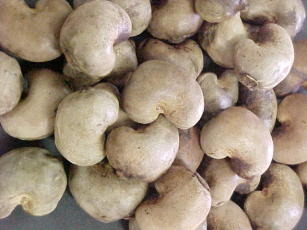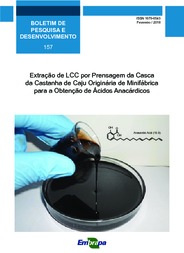Researchers extract antimicrobial substance from cashew nut shell
Researchers extract antimicrobial substance from cashew nut shell
About 65% of the composition of the Cashew Nut Shell Liquid (CNSL) is formed by anacardic acids, a class of substances with antioxidant and antimicrobial effect, and some studies show potential antitumor and antiparasitic action (see box below the news report). Researchers from Embrapa Tropical Agroindustry's Multiuser Laboratory of Chemistry of Natural Products developed a process to extract, purify and quantify such compounds, which paves the way for a new marketable route in cashew farming.
According to the Embrapa researcher Edy Brito, despite the anacardic acids' biological activity having been known since the 1940s, the most abundant source of said substances is wasted. In large cashew processing industries, the high temperatures used in processing degrade the acids present in the CNSL. In small factories, although degradation does not occur during the processing, the shells, which correspond to 70% of the nut weight, are either discarded or fire their furnaces. “Burning them is an issue, because it can generate toxic gases ”, the scientist warns.
The method of quantification and isolation developed by Embrapa is the first step to commercially explore anacardic acids, which are currently not available in the market. “Obtaining reproducible parameters is an important stage to make the use of such substances possible for different purposes”, clarifies the researcher. The parameters developed will become a model for quality control in different studies, including those for possible future commercial uses.
Understand the processTo use the material, the process starts with pressing the shells and obtaining the liquid that is rich in anacardic acids. The residue, or the meal from the press, is being studied for the production of MDF or plywood. From the liquid, the researchers obtained calcium anacardate and the anacardic acids, which are a mixture of three similarly structured acids that are hard to separate. The team isolated each acid and validated a methodology to quantify each of the three types. The researchers generated enough amounts to conduct biological tests and produce analytical standards. The work evolved into the definition of operational parameters for the preparatory scale (when the amounts move from microgram to hundreds of milligrams). The results included the development of quality control standards using high-pressure liquid chromatography equipment. The next step of the research was improving the processes to increase efficiency. In the preparatory scale, it was possible to double the yield in grams per hour (with pureness above 95%), thus halving the consumption of solvent. With this scale, it is possible to supply material for quality control and biological tests. |
Applications in the fight against cancer
The first records in the scientific literature related to anacardic acids evidenced their antimicrobial action. “Nowadays there are studies assessing their cytotoxicity and use to fight cancer cells ”, the researcher Edy Brito states. According to him, there is already a patent for coccidiosis control in domestic animals.
Since 2016 they have been studying, in partnership with Embrapa Goats and Sheep, the antiparasitic activity of the anacardic acids in goats and sheep. The researcher Marcel Teixeira explains that resistance to worms is currently the biggest challenge related to parasite control for such animals. He believes that the substance can work as an antiparasitic agent and by modulating the transport channels that give resistance to specific classes of anthelmintic drugs.
“It could be a solution for situations in which resistance is established, which is of great interest for the veterinary industry", the researcher says. The first study results indicate in-laboratory ovicidal and larvicidal action over the nematode H. contortus; however, its effect modulating anthelmintic resistance is still under investigation.
Another line of research developed by the Federal University of Ceará (UFC) assesses the use of the acids as antioxidant food additives, especially in products that present fats. “Studies have shown that they prevent meat oxidation, which can improve the shelf life of products like cold cuts, for example ”, says the researcher. A possible application is the use as additive in animal feed. There are other ongoing assessments of biological activities at Embrapa Genetic Resources and Biotechnology.
Chemistry of natural products is opportunity for BrazilBioactive compounds that have been identified in plants, animals and microorganisms are widely used in the pharmaceutical and agrochemical industries. In the United States, a survey made between 1981 and 2014 showed that 30% of all drugs approved by the Food and Drug Administration (FDA) are genuinely natural, sourced from natural products or synthecized based on models that exist in nature. Among anticancer drugs, this percentage jumps to 55%. Similarly, natural products take a prominent place in the agrochemical sector, as in that country they represent about a third of insecticide and fungicide sales, as well as 12% of herbicides'. In Brazil, given the size of the agricultural pharmaceutical market and the wealth of national biodiversity, natural products are still economically underexplored for those purposes. That is why researchers anticipate great opportunities of progress in the bioindustry in the upcoming decades. A research group from Embrapa Tropical Agroindustry has been working on a key stage for the use of underexplored bioactive substances: the development and validation of analytical methods for the quantification of natural compounds. In general, these elements are secondary metabolites that are found in extremely low amounts, which requires precise sensitive analyses for which parameters are often not available in the market. The work includes the development of standards for the calibration of the equipment and the validation of reproducible methods. The development of such protocols is based on international quality recommendations, criteria and standards. Last year, the team stationed at the Multiuser Laboratory of Chemistry of Natural Products developed not only the method for the quantification of anacardic acids present in the Cashew Nut Shell Liquid, but also methods to quantify lipopeptids produced by Bacillus subtilis; urudeuvins found in urunday; alkaloids from amaryllis; and three substances from the tropical daisy Egletes viscosa: ternatin, centipedic acid, and lactone of hawtriwaic acid. They also provided a protocol for chlorogenic acid from yacon, as well as standards for more than 20 phenolic compounds present in tropical fruits. The methods comprise basic tools for quality control, for the development of products from bioactive substances, and for the assessment of the stability and yield of raw material. They are also fundamental for biological trials. The results are the basis for the development of studies like natural product quality assessments and for the development of plant production systems that supply raw material for industries, among many other applications. |
Translation: Mariana Medeiros
Verônica Freire (MTb 01225/CE)
Embrapa Tropical Agroindustry
Press inquiries
agroindustria-tropical.imprensa@embrapa.br
Phone number: +55 85 3391-7116
Further information on the topic
Citizen Attention Service (SAC)
www.embrapa.br/contact-us/sac/



